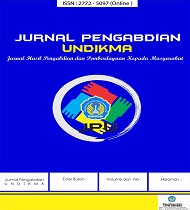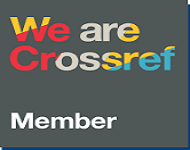Factors Influencing Peers' Attitudes towards Students with Special Needs in Indonesia : The Role of Moral Identity, Empathy, Age, and Gender
DOI:
https://doi.org/10.33394/jk.v9i4.9191Keywords:
Attitudes, Peers, Students with Disabilities, Moral Identity, Empathy, Age, Gender.Abstract
This study aims to analyze the factors influencing peer attitudes towards students with special educational needs and disabilities (SEND), seen from the role of moral identity, empathy, age, and gender. This study uses a quantitative approach with a non-experimental method of cross-sectional design. The respondents were 288 Indonesian students aged 18-25(M = 19.67 years, SD = 1.23), with 62.9% female and 37.1% male. The instrument used was a questionnaire distributed via social media, and the data was analyzed by correlation analysis, ANOVA, and SEM. The results showed that age did not correlate with attitudes towards college students with SEND. There is no difference between male and female students. Moral identity was negatively associated with negative attitudes towards college students with SEND, both in total, affective, cognitive, and behavioral dimensions. The dimensions of fantasy, perspective-taking, and empathic concern can mediate the relationship between the two. The results of the study provide implications for increasing positive peer attitudes towards college students with SEND by encouraging the development of moral identity and empathy.
References
Andreev, A., Mandoo, F., Pociūtė, V., & Vardanyan, M. (2019). Youth attitudes towards physically disabled people and factors influencing them. Downloaded from https://www.researchgate.net/publication/352836731
Athamanah, L. S., Fisher, M. H., Sung, C., & Han, J. E. (2020). The Experiences and perceptions of college peer mentors interacting with students with intellectual and developmental disabilities. Research and Practice for Persons with Severe Disabilities, 45(4), 271-287. https://doi.org/10.1177/1540796920953826.
Black, J. E., & Reynolds, W. M. (2016). Development, reliability, and validity of the Moral Identity Questionnaire. Personality and Individual Differences, 97, 120-129.
Bossaert, G., Colpin, H., Pijl, S. J., & Petry, K. (2011). The attitudes of Belgian adolescents towards peers with disabilities. Research in Developmental Disabilities, 32, 504-509. 9. https://doi.org/10.1016/j.ridd.2010.12.033.
Carter, E. W., Gustafson, J. R., Mackay, M. M., Martin, K. P., Parsley, M. V., Graves, J., ... & Cayton, J. (2019). Motivations and expectations of peer mentors within inclusive higher education programs for students with intellectual disabilities. Career Development and Transition for Exceptional Individuals, 42(3), 168-178.
Clark, M. A., Robertson, M. M., & Young, S. (2019). "I feel your pain": A critical review of organizational research on empathy. Journal of Organizational Behavior, 40(2), 166-192. https://doi.org/ 10.1002/job.2348
de Boer, A, Pijl, S. J., & Minnaert, A. (2012): Students' Attitudes towards Peers with Disabilities: A review of the literature. International Journal of Disability, Development and Education, 59(4), 379-392. http://dx.doi.org/10.1080/1034912X.2012.723944
de Laat, S., Freriksen, E., & Vervloed, M. P. J. (2013). Attitudes of children and adolescents towards persons who are deaf, blind, paralyzed or intellectually disabled. Research in Developmental Disabilities, 34(2), 855-63.
DetikNews. (2017). Gunadarma Student with Special Needs Often Bullied in Class. Accessed September 12, 2023 from the page: https://news.detik.com/berita
Eagly, A., & Chaiken, S. (1993). The psychology of attitudes. Harcourt Brace Jovanovich, Fort Worth, TX.
Eisenberg, N., & Fabes, R. A. (1999). Emotion, emotion-related regulation, and quality of socioemotional functioning.
Evanjeli, L. A. (2021). Students' knowledge and attitudes towards inclusion in college. Cakrawala Pendidikan, 40, 1. doi:10.21831/cp.v40i1.36150
Findler, L., Vilchinsky, N., & Werner, S. (2007). The multidimensional attitudes scale towards persons with disabilities (MAS): Construction and validation. Rehabilitation Counseling Bulletin, 50, 166-176. https://doi.org/10.1177/00343552070500030401
Fishbein, M., & Ajzen, I. (2005). The influence of attitudes on behavior. The Handbook of Attitudes, 173-222.
Hardy, S. A. (2006). Identity, reasoning, and emotion: An empirical comparison of three sources of moral motivation. Motivation and Emotion, 30(3), 205-213. 10.1007/s11031-006-9034-9.
Hardy, S. A., & Carlo, G. (2005). Identity as a source of moral motivation. Human Development, 48, 232-256. https://doi.org/10.1159/000086859
Hardy, S. A., Walker, L. J., Olsen, J. A., Woodbury, R. D., & Hickman, J. R. (2014). Moral identity as moral ideal self: Links to adolescent outcomes. Developmental Psychology, 50(1), 45-57. https://doi.org/10.1037/a0033598.
Hertz, S. G., & Krettenauer, T. (2016). Does moral identity effectively predict moral behavior? A meta-analysis. Review of General Psychology, 20, 129-140. https://doi.org/10.1037/gpr0000062.
Israelashvili, J., Sauter, D., & Fischer, A. (2020). Two facets of affective empathy: concern and distress have opposite relationships to emotion recognition. Cognition and Emotion, 34(6), 1112-1122. https://doi.org/10.1080/02699931.2020.1724893
Lapsley, D. K., & Narvaez, D. (2004). A Social-Cognitive Approach to the Moral Personality. In D. K. Lapsley & D. Narvaez (Eds.) Moral development, self, and identity (pp. 189-212). Lawrence Erlbaum Associates Publishers.
Morgan, B, & Fowers, B. (2023). Empathy and authenticity online: The roles of moral identity, moral disengagement, and parenting style. Journal of Personality, 90(2), 183-202. 10.1111/jopy.12661
Morin, D., Rivard, M., Crocker, A. G., Boursier, C. P., & Caron, J. (2013). Public attitudes towards intellectual disability: a multidimensional perspective attitudes on intellectual disabilities. Journal of Intellectual Disability Research, 57(3), 279-92.
Nevill, R. E. A., & White, S. W. (2011). College students' openness towards autism spectrum disorders: Improving peer acceptance. Journal of Autism and Developmental Disorders, 41, 1619-1628. DOI 10.1007/s10803-011-1189-x.
Nowicki, E. A. (2006). A cross-sectional multivariate analysis of children's attitudes towards disabilities. Journal of Intellectual Disability Research, 50, 335-348.
Page, S. L., & Islam, M. R. (2015). The role of personality variables in predicting attitudes towards people with intellectual disability: An Australian perspective. Journal of Intellectual Disability Research, 59, 741-745. https://doi.org/10.1111/jir.12180.
Patka, M., Keys, C. B., Henry, D. B., & McDonald, K. E. (2013). Attitudes of Pakistani community members and staff towards people with intellectual disability. American journal on intellectual and developmental disabilities, 118(1), 32-43.
Polo, M.T., Fernandez-Jimenez, C., & Fernandez, Ma. (2017). The attitudes of different partners involved in higher education towards students with disabilities. International Journal of Disability Development Education, 65(4), 442-458. https://doi.org/10.1080/1034912X.2017.1406066.
Powell, P. A., & Roberts, J. (2017). Situational determinants of cognitive, affective, and compassionate empathy in naturalistic digital interactions. Computers in Human Behavior, 68, 137-148. https://doi.org/10.1016/j.chb.2016.11.024
Sharma, N., Pratap, Y. V, Sharma, A. (2021). Attitudes and empathy of youth towards physically disabled persons. Heliyon, 7(8). doi: 10.1016/j.heliyon.2021.e07852. PMID: 34466710; PMCID: PMC8383054.
Swaim, K. F., & Morgan, S. B. (2001). Children's attitudes and behavioral intentions towards a peer with autistic behaviors: Does a brief educational intervention have an effect? Journal of Autism and Developmental Disorders, 31, 195-205.
Szumski, G., Smogorzewska, J., & Grygiel, P. (2020). Attitudes of students towards people with disabilities, moral identity and inclusive education-A two-level analysis. Research in Developmental Disabilities, 102. https://doi.org/10.1016/j.ridd.2020.103685.
UNESCO. (1994). The Salamanca Statement and Framework for action on special needs education: Adopted by the World Conference on Special Needs Education; Access and Quality. Salamanca, Spain, June 7-10, 1994. UNESCO.
Law of the Republic of Indonesia Number 8 Year 2016. (2016). Persons with Disabilities. Jakarta.
United Nations. (2015). The 17 Goals. Accessed August 31, 2023 from: https://sdgs.un.org/goals
United Nations Sustainable Development Group. (2022). Operationalizing Leaving No One Behind.
Vignes, C., Godeau, E., Sentenac, M., Coley, N., Navarro, F., Grandjean, H., et al. (2009). Determinants of students' attitudes towards peers with disabilities. Developmental Medicine and Child Neurology, 51, 473-479. https://doi.org/10.1111/j.1469-8749.2009.03283.x.
Vincent-Onabajo, G. O. & Malgwi, W.S. (2015). Attitude of physiotherapy students in Nigeria towards persons with disability. Disability and Health Journal, 8(1): 102-8.
Wang, H., Ao, L., Gao, Y., Liu, Y., & Zhang, X. (2023). Empathy for pain in individuals influenced by moral identity: Evidence from an ERP study. Physiology and Behavior, 266. https://doi.org/10.1016/j.physbeh.2023.114202
Zheng, Q., Tian, Q., & Hao, C. (2016). Comparison of attitudes towards disability and people with disability among caregivers, the public, and people with disability: findings from a cross-sectional survey. BMC public health, 16(1), 1024.
Downloads
Additional Files
Published
How to Cite
Issue
Section
Citation Check
License
License and Publishing Agreement
In submitting the manuscript to the journal, the authors certify that:
- They are authorized by their co-authors to enter into these arrangements.
- The work described has not been formally published before, except in the form of an abstract or as part of a published lecture, review, thesis, or overlay journal.
- That it is not under consideration for publication elsewhere,
- That its publication has been approved by all the author(s) and by the responsible authorities tacitly or explicitly of the institutes where the work has been carried out.
- They secure the right to reproduce any material that has already been published or copyrighted elsewhere.
- They agree to the following license and publishing agreement.
Copyright
Authors who publish with JK agree to the following terms:
- Authors retain copyright and grant the journal right of first publication with the work simultaneously licensed under a Creative Commons Attribution License (CC BY-SA 4.0) that allows others to share the work with an acknowledgment of the work's authorship and initial publication in this journal.
- Authors are able to enter into separate, additional contractual arrangements for the non-exclusive distribution of the journal's published version of the work (e.g., post it to an institutional repository or publish it in a book), with an acknowledgment of its initial publication in this journal.
- Authors are permitted and encouraged to post their work online (e.g., in institutional repositories or on their website) prior to and during the submission process, as it can lead to productive exchanges, as well as earlier and greater citation of published work.
Licensing for Data Publication
-
Open Data Commons Attribution License, http://www.opendatacommons.org/licenses/by/1.0/ (default)

This work is licensed under a Creative Commons Attribution-ShareAlike 4.0 International License.







